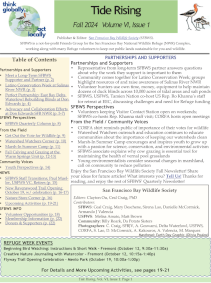San Francisco Bay Area voters pass Measure AA for a clean and healthy Bay
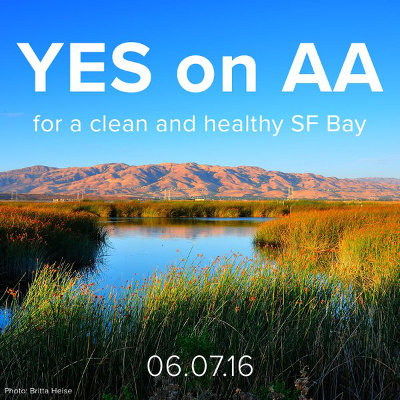
A poster for the Yes on AA campaign by Save the Bay. Photo courtesy Britta Heise via Twitter.
Measure AA, a tax measure on the ballot for the nine counties surrounding the San Francisco Bay, was approved with a 69% Yes vote on June 7, 2016 election day. The measure will raise $25 million in annual revenue over 20 years through an annual parcel tax of $12 assessed on property owners falling within the jurisdiction of the San Francisco Bay Restoration Authority. The $500 million total revenue is earmarked "to protect San Francisco Bay for future generations by reducing trash, pollution and harmful toxins, improving water quality, restoring habitat for fish, birds and wildlife, protecting communities from floods, and increasing shoreline public access." The measure includes independent citizen oversight and annual audits to ensure transparency. It also mandates that all funds stay local.
The San Francisco Bay Restoration Authority (SFBRA) is a California state government agency charged with the restoration and protection of wetlands and wildlife habitat in the San Francisco Bay and along its shoreline. Its jurisdiction emcompasses nine counties: San Francisco, San Mateo, Santa Clara, Alameda, Contra Costa, Solano, Napa, Sonoma and Marin. It has put forward a rough plan to restore 30,000 acres of tidal marshland at a cost of about $1.5 billion.
SFBRA is authorized to assess the parcel tax for a period of 20 years, from July 1, 2017 through June 30, 2037. The parcel tax would appear on residents’ property tax bills as a separate line item. Proceeds from the parcel tax would be deposited in a separate account, with total administrative expenditures limited to no more than 5% of the revenue raised. SFBRA would award the first restoration funds in 2018. It would allocate half the funds to the North Bay, East Bay, South Bay, and West Bay proportional to their populations, with the remaining 50% allocated to projects within its jurisdiction without regard to location.
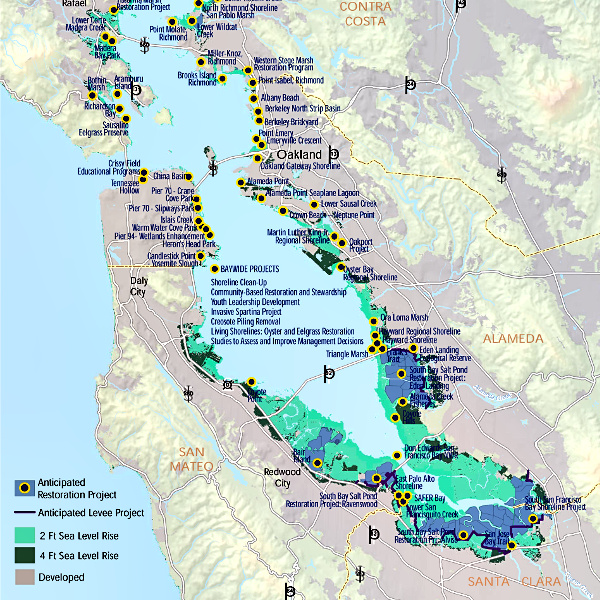
Anticipated restoration projects around the San Francisco Bay Area in February 2016. Map courtesy San Francisco Bay Restoration Authority.
Save the Bay, a local environmental protection group, campaigned aggressively in support of Measure AA with the slogan "Yes on AA". The measure also received support from local politicians and businessmen. United States Senator Dianne Feinstein (D-Calif.) said that "passing this critical measure will ensure that our children and grandchildren inherit a clean and healthy San Francisco Bay." Jim Wunderman, CEO of the Bay Area Council business association, said, "By acting now to restore our wetlands, we can improve the Bay ecosystem for fish and wildlife while protecting huge portions of the Bay shoreline from storm surges and rising seas." San Mateo County Supervisor Dave Pine, the chair of the restoration authority's governing board, said, "This is really an unprecedented regional collaboration to take on a very challenging regional issue, which is the health of the Bay and providing natural flood protection." The San Francisco League of Conservation Voters said "Funding is desperately needed to restore San Francisco Bay’s wetlands and help protect the region from the effects of rising seas. This modest $12 annual parcel tax would [...] restore wildlife habitat, improve water quality, and create a buffer against storms and sea level rise."
A "Stop Measure AA" campaign urged voters to reject the measure since the tax would be economically regressive, and also unfair to residents who lived far from the bay and did not benefit from its health as much as other residents. Jack Weir, president of the Contra Costa Taxpayers Association, said "Measure AA is more about filling politicians’ pockets than it is about helping the environment." He pointed out that that the measure doesn't specify how the money will be spent and that proposed projects won't need an evaluation from a scientific advisory board. The additional parcel tax would add to property taxes, driving up housing costs for residents. Paul Premo of the Citizens for Sustainable Pension Plans said that the money raised by the measure would be spent by unelected officials of the San Francisco Bay Restoration Authority, meaning "taxation without representation" and creating another regional bureacracy.
On June 7, 2016 Measure AA was put before voters at the election ballot, requiring a two-thirds supermajority vote to pass.
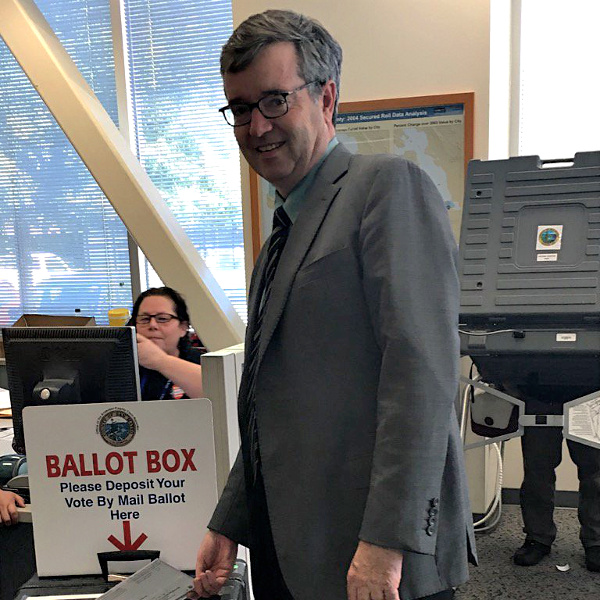
Dave Pine, the chair of the San Francisco Bay Restoration Authority's governing board, votes for Measure AA on June 7, 2016 election day. Photo courtesy Dave Pine via Twitter.
Preliminary election results indicate that the measure passed with 69% of the total vote. With about 1.3 million votes counted by late afternoon on June 9, the measure won by a margin of 510,600 votes. The measure got over 70% approval in San Francisco, Alameda and Marin counties but fell short of the two-thirds threshold in Contra Costa, Sonoma, Napa and Solano counties.
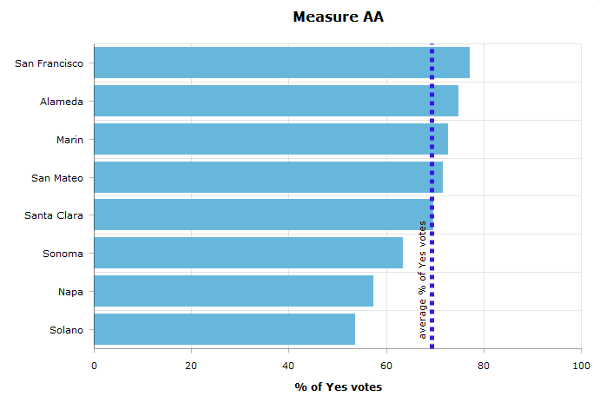
Percentage of Yes votes for Measure AA by county on June 7, 2016 election day. Data courtesy San Francisco Bay Restoration Authority.
| Note: Preliminary election results based on 1,318,162 ballots counted by 4:13 PM on June 9, 2016. | |
| County | % of Yes vote |
|---|---|
| San Francisco | 77.13% |
| Alameda | 74.60% |
| Marin | 72.49% |
| San Mateo | 71.49% |
| Santa Clara | 69.66% |
| Contra Costa | 64.92% |
| Sonoma | 63.28% |
| Napa | 57.19% |
| Solano | 53.45% |
| Total | 69.37% |
David Lewis, executive director of Save the Bay, said that "(Tuesday’s) vote is a resounding victory for wildlife and people who want a healthy, beautiful Bay for future generations".
“We would like to thank the many business, environment, labor and community leaders across the region who strongly supported the measure, as well as our elected leaders at all levels of government,” said Silicon Valley Leadership Group president Carl Guardino. “It is because of your efforts and support for this initiative that we will now be able to address one of our most pressing regional issues – protecting San Francisco Bay from the threat of rising seas and a changing world climate.”
“Bay Area voters made a terrific investment to restore San Francisco Bay and leave a legacy that will be cherished for generations,” said Michael Mantell, President of Resources Legacy Fund. “It’s a great testament to collaboration, and this investment can leverage additional state and federal support the Bay needs to be healthy.”
"The San Francisco Bay Restoration Authority Board is thrilled by tonight’s result and the public’s support for our mission to restore the Bay," said Dave Pine, San Mateo County Supervisor and Chair of the San Francisco Bay Restoration Authority. "We look forward to utilizing these funds in a fiscally responsible way to do the important work of preserving a healthy San Francisco Bay."

